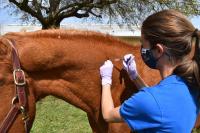10 Things You Might Not Know About Equine Vaccines
There’s no one-size-fits-all when it comes to equine vaccinations. We collaborated with UC Davis infectious disease expert Dr. Nicola Pusterla to share ten things you might not know about equine vaccines.
1. Vaccines stimulate the immune system to create antibodies that can recognize a disease-causing pathogen in the future and destroy it. If the horse encounters the pathogen through natural infection, the immune system will be able to mount a strong, rapid response, limiting or preventing clinical signs and reducing the spread of disease.
2. Protection provided by vaccines is not immediate and can fade over time. It can take from days to weeks for horses to mount optimal immune responses following vaccination. Most vaccines require two or three initial administrations (spaced about 4-6 weeks apart) and boosters annually or every six months.
3. Vaccination alone is not enough to prevent infectious diseases. Effective infectious disease control relies on a combination of appropriate biosecurity protocols coupled with vaccination programs and management considerations.
4. Vaccines are labeled for different levels of protection. Levels-of-protection statements can be granted by the United States Department of Agriculture (USDA) based on product performance data. The highest level of protection label claim is “prevention of infection”, followed by (in declining order) “prevention of disease”, “aid in disease prevention”, and “aid in disease control”. Other claims, such as “reduced pathogen shedding”, may be made if data supports a significant clinical effect.

5. There are specific vaccination guidelines for foals and pregnant mares. Foals rely on maternal antibodies from colostrum to protect against diseases. Vaccination in pregnant mares should be timed for optimal protection of both the mare and foal. For example, an EHV-1 vaccine for the prevention of abortion is often administered during months five, seven, and nine of gestation. An EHV-1/EHV-4 vaccine is then administered four to six weeks prior to foaling to decrease the risk of respiratory disease in the foal. Since maternal antibodies decline over time, foals begin the primary series for recommended vaccines around four to six months of age. This should start sooner if the mare was not appropriately vaccinated or if there was failure of passive transfer.

6. Intramuscular (IM) vaccines should be given in the neck, pectoral muscles, or hamstrings. When choosing a vaccination site, it is important to consider potential adverse reactions. For example, if an abscess were to develop, sites that facilitate gravitational drainage, such as the hamstrings, will have swifter resolution and less tissue damage than sites that present challenges for drainage, such as the gluteal muscles.
7. Vaccinated horses can still get sick, but they will be less sick, and at less risk of exposing others, than if they did not receive a vaccine. Vaccines cannot provide 100% protection under all circumstances. Although some may be able to prevent disease, others only claim to reduce the severity of disease (see #4). With the latter, vaccinated horses that become infected have milder clinical signs than infected horses that have not been vaccinated. Studies have also shown that vaccinated horses can exhibit reduced pathogen shedding into the environment, reducing risk of infection for naïve horses.
8. Not all diseases need a vaccine. It is expensive and time-consuming to gain approval and bring a new vaccine to market. Diseases that are comparatively rare, do not result in severe or life-threatening clinical signs, or that are effectively controlled by alternative means such as management and biosecurity programs, are not likely to be good candidates for vaccine development. Alternatively, the “core vaccines” were developed to protect against high-risk diseases that have important health significance.
9. Horses should be vaccinated even if they are “home bodies”. All horses should receive the “core vaccines” recommended by the AAEP, which are for diseases that have high mortality rates and high likelihood of exposure. Some pathogens exist in the environment, and vectors such as the mosquito and wild animals like raccoons can transport these pathogens to your horse’s location. Work with your veterinarian to determine if risk-based vaccines are recommended based on your specific situation.

10. It is important to vaccinate at the right time of year to ensure protection during peak exposure. Vaccine administration should be timed to ensure protective immunity coincides with, and lasts through, periods of likely exposure. For example, vaccination against vector-borne diseases such as West Nile virus should be administered prior to the beginning of mosquito season.
